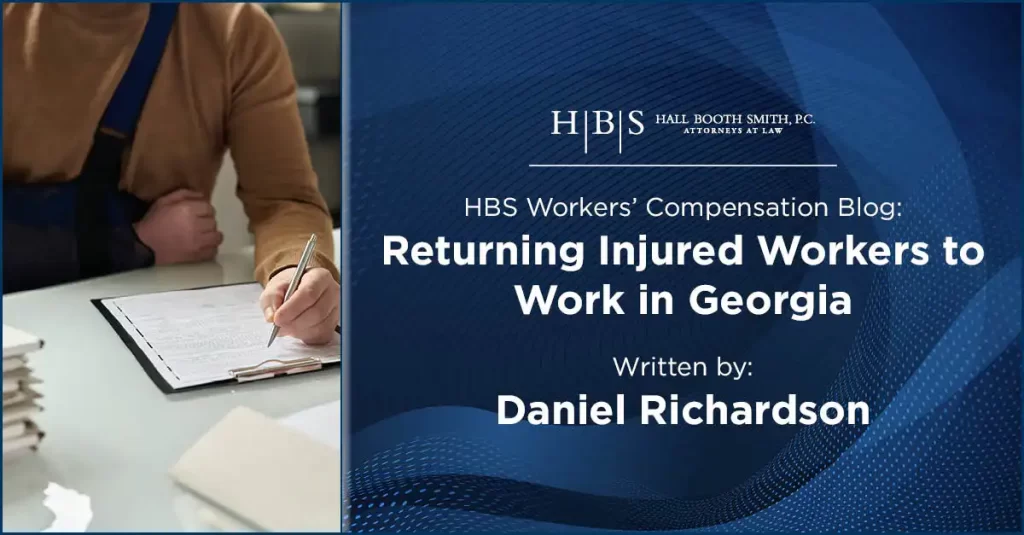
Returning Injured Workers to Work in Georgia
 Written by: Daniel Richardson, Esq.
Written by: Daniel Richardson, Esq.
The longer an employee stays out of work, the less likely they are to ever return. And workers compensation claims become increasingly expensive when employees do not return. To manage this exposure, it is important to have a good return-to-work program and to communicate clearly regarding your expectation that you will work with the injured worker to have them back as soon as possible.
Overview
Now, to the nuts and bolts of it, at least in Georgia. The law in Georgia provides a powerful tool to employers and insurers in the return-to-work process under OCGA 34-9-240. This tool is useful when the claimant is out of work receiving Temporary Total Disability (TTD) benefits but has received light duty restrictions from their Authorized Treating Physician (ATP).
If you carefully follow the steps laid out under this statute, you can attempt to bring the claimant back to work, and if they refuse to return to work, you may unilaterally suspend their TTD benefits. It is a tremendous advantage to not have to wait until a hearing to get TTD benefits stopped. Getting the claimant’s benefits stopped in this way may be what finally brings them around to a reasonable settlement if that is your goal.
Alternately, the mere threat to bring them back to work under OCGA 34-9-240 may be what sobers them up to be realistic in negotiations.
Steps
Once you are ready, here are the steps:
- First, consider whether the claimant has light duty restrictions from the ATP.
- Second, check whether the employer can accommodate the restrictions.
- Third, obtain a light duty job description from the employer. You may use a WC-240A form, or a clearly worded and detailed job description. You will need to describe the essential job duties, hours to be worked, rate of pay, and a description of essential tasks.
- Fourth, send the WC-240A or detailed job description to the ATP and concurrently send copies to the claimant and their attorney if they are represented. You need to get the ATP to approve the job description, but the approval must be within 60 days of the last examination of the claimant by the ATP. Therefore, you may need to schedule for the claimant to have an appointment with the ATP to meet this requirement. Also keep in mind that the approval needs to come from the ATP, and not simply from an IME or a referral physician.
- Fifth, once the job description has been approved, fill out a WC-240 form with details including the date and time of the return-to-work, rate of pay, and contact information for the claimant’s supervisor. Send a copy of the WC-240 to the claimant and their attorney, if represented, at least 10 days in advance of the return-to-work date. It may be best to aim for two weeks’ advance notice, in case any issues arise, and it is also a good practice to communicate with the claimant a couple of days in advance to remind them. It is imperative that your team at work know that the claimant is returning and that there is, in fact, a job waiting as described. The process falls apart if the claimant shows up to work and is turned away by a supervisor who was unaware of what was going on.
- Sixth, if the claimant fails to return to work, or returns but leaves before working a full workday or eight cumulative hours, whichever is greater, you may file a WC-2 unilaterally suspending the claimant’s TTD benefits. Attach the WC-240 and WC-240A to the WC-2 as you are filing. If you are able to suspend TTD benefits, you also need to consider whether the claimant is at Maximum Medical Improvement (MMI), in which case you may need to commence Permanent Partial Disability (PPD) benefits.
Conclusions
If the Claimant works more than eight cumulative hours or one scheduled workday, whichever is greater, but less than 15 days, income benefits must be immediately reinstated. If they are not, you waive the ability to argue before the judge that the claimant is unjustifiably refusing suitable light duty employment.
In other words, you can still go before the judge and argue that TTD should be owing, but you will have to pay TTD in the meantime until you get to court.
Ultimately, the WC-240 process is a great piece of leverage which can be useful in bringing your claims to a resolution, and if you have any questions about its use, please feel free to contact me or anyone on our dedicated Workers’ Compensation team.
Disclaimer
This material is provided for informational purposes only. It is not intended to constitute legal advice nor does it create a client-lawyer relationship between Hall Booth Smith, P.C. and any recipient. Recipients should consult with counsel before taking any actions based on the information contained within this material. This material may be considered attorney advertising in some jurisdictions. Prior results do not guarantee a similar outcome.


Leave a comment
You must be logged in to post a comment.